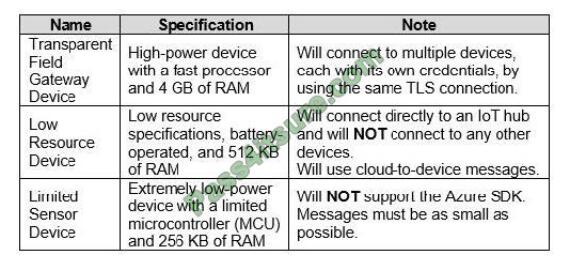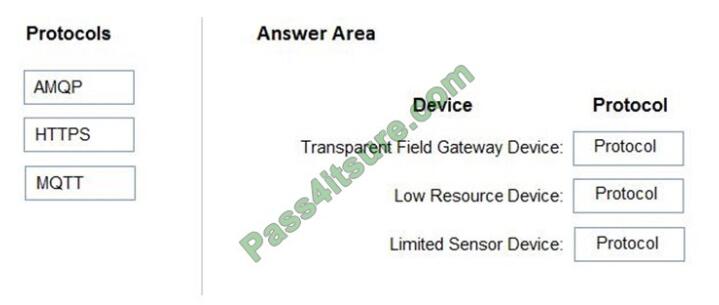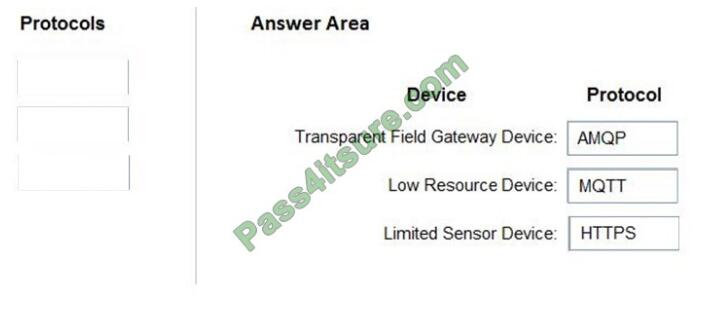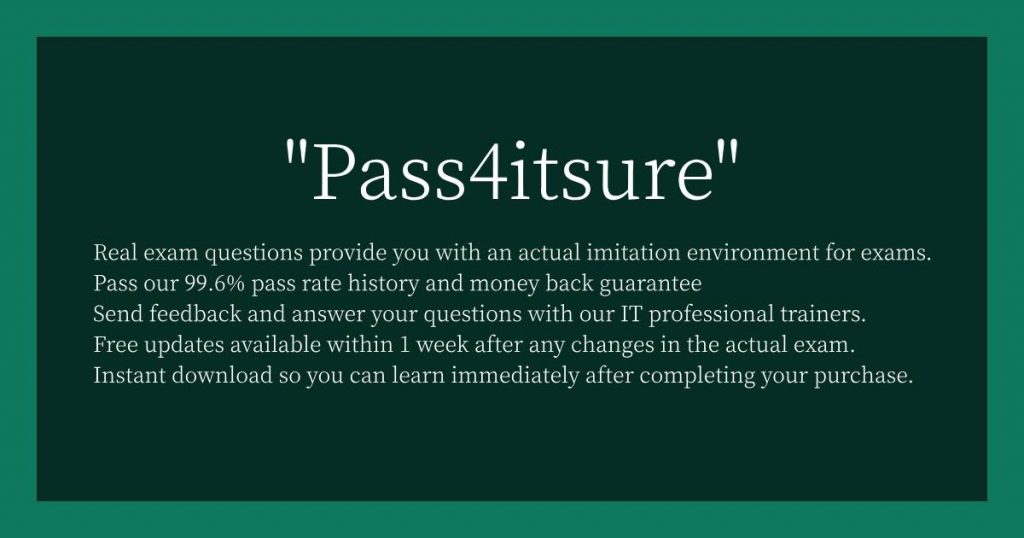Best Quality Microsoft Azure IoT Developer Specialty AZ-220 Exam Questions [100% Free]
Where is the best quality Microsoft Azure AZ-220 Exam Question to help me pass the exam? Pass4itsure provides you with questions and tips for Microsoft Azure AZ-220 dumps (https://www.pass4itsure.com/az-220.html), which will ensure your success in the first attempt of the AZ-220 exam.
az-220 dumps | Microsoft exam dumps | az-220 exam questions | az-220 practice test | az-220 questions
![AZ-220 Exam Questions [100% Free]](https://www.pmtrainingprep.com/wp-content/uploads/2020/06/Microsoft-Azure-IoT-Developer-Specialty-AZ-220-Exam-Questions-100-Free-1024x415.jpg)
Microsoft Azure IoT Developer Specialty AZ-220 Exam Dumps Pdf – Download
AZ-220 Exam Dumps Pdf
https://drive.google.com/file/d/1VtdQjECnAwo1AMJsREFWsTdVfF6Ie-EU/view?usp=sharing
Microsoft Azure AZ-220 Exam Practice Questions [2020 Updated, Real]
QUESTION 1
You have three Azure IoT hubs named Hub1, Hub2, and Hub3, a Device Provisioning Service instance, and an IoT
device named Device1.
Each IoT hub is deployed to a separate Azure region.
Device enrollment uses the Lowest latency allocation policy.
The Device Provisioning Service uses the Lowest latency allocation policy.
Device1 is auto-provisioned to Hub1 by using the Device Provisioning Service.
Device1 regularly moves between regions.
You need to ensure that Device1 always connects to the IoT hub that has the lowest latency.
What should you do?
A. Configure device attestation that uses X.509 certificates.
B. Implement device certificate rolling.
C. Disenroll and reenroll Device1.
D. Configure the re-provisioning policy.
Correct Answer: D
Automated re-provisioning support.
Microsoft added first-class support for device re-provisioning which allows devices to be reassigned to a different IoT
solution sometime after the initial solution assignment. Re-provisioning support is available in two options:
Factory reset, in which the device twin data for the new IoT hub is populated from the enrollment list instead of the old
IoT hub. This is common for factory reset scenarios as well as leased device scenarios.
Migration, in which device twin data is moved from the old IoT hub to the new IoT hub. This is common for scenarios in
which a device is moving between geographies.
Reference:
https://azure.microsoft.com/en-us/blog/new-year-newly-available-iot-hub-device-provisioning-service-features/
QUESTION 2
You have 1,000 devices that connect to an Azure IoT hub.
You are performing a scheduled check of deployed IoT devices.
You plan to run the following command from the Azure CLI prompt.
az iot hub query –hub-name hub1 –query-command “SELECT * FROM devices WHERE connectionState = \\’Disconnected\\'”
What does the command return?
A. the Device Disconnected events
B. the device twins
C. the Connections logs
D. the device credentials
Correct Answer: A
The IoT Hub publishes Microsoft.Devices.DeviceDisconnected event type, which is published when a device is
disconnected from an IoT hub.
Reference: https://docs.microsoft.com/en-us/azure/iot-hub/iot-hub-event-grid#event-types
QUESTION 3
You have an Azure IoT hub.
You need to recommend a solution to scale the IoT hub automatically.
What should you include in the recommendation?
A. Create an SMS alert in IoT Hub for the Total number of messages used metric.
B. Create an Azure function that retrieves the quota metrics of the IoT hub.
C. Configure autoscaling in Azure Monitor.
D. Emit custom metrics from the IoT device code and create an Azure Automation runbook alert.
Correct Answer: B
Note: IoT Hub is scaled and priced based on an allowed number of messages per day across all devices connected to
that IoT Hub. If you exceed the allowed message threshold for your chosen tier and number of units, IoT Hub will begin
rejecting new messages. To date, there is no built-in mechanism for automatically scaling an IoT Hub to the next level of
capacity if you approach or exceed that threshold.
Reference: https://docs.microsoft.com/en-us/samples/azure-samples/iot-hub-dotnet-autoscale/iot-hub-dotnet-autoscale/
QUESTION 4
You have 10,000 IoT devices that connect to an Azure IoT hub. The devices do not support over-the-air (OTA) updates.
You need to decommission 1,000 devices. The solution must prevent connections and autoenrollment for the
decommissioned devices.
Which two actions should you perform? Each correct answer presents part of the solution.
NOTE: Each correct selection is worth one point.
A. Update the connectionState device twin property on all the devices.
B. Blacklist the X.509 root certification authority (CA) certificate for the enrollment group.
C. Delete the enrollment entry for the devices.
D. Remove the identity certificate from the hardware security module (HSM) of the devices.
E. Delete the device identity from the device registry of the IoT hub.
Correct Answer: BC
B: X.509 certificates are typically arranged in a certificate chain of trust. If a certificate at any stage in a chain becomes
compromised, trust is broken. The certificate must be blacklisted to prevent Device Provisioning Service from
provisioning devices downstream in any chain that contains that certificate.
C: Individual enrollments apply to a single device and can use either X.509 certificates or SAS tokens (in a real or virtual
TPM) as the attestation mechanism. (Devices that use SAS tokens as their attestation mechanism can be provisioned
only through an individual enrollment.) To blacklist a device that has an individual enrollment, you can either disable or
delete its enrollment entry.
To blacklist a device that has an individual enrollment, you can either disable or delete its enrollment entry.
Reference: https://docs.microsoft.com/en-us/azure/iot-dps/how-to-revoke-device-access-portal
QUESTION 5
You develop a custom Azure IoT Edge module named temperature-module.
You publish temperature-module to a private container registry named mycr.azurecr.io
You need to build a deployment manifest for the IoT Edge device that will run temperature-module.
Which three container images should you define in the manifest? Each correct answer presents part of the solution.
NOTE: Each correct selection is worth one point.
A. mcr.microsoft.com/azureiotedge-simulated-temperature-sensor:1.0
B. mcr.microsoft.com/azureiotedge-agent:1.0
C. mcr.microsoft.com/iotedgedev:2.0
D. mycr.azurecr.io/temperature-module:latest
E. mcr.microsoft.com/azureiotedge-hub:1.0
Correct Answer: BDE
Each IoT Edge device runs at least two modules: $edgeAgent and $edgeHub, which are part of the IoT Edge runtime.
IoT Edge device can run multiple additional modules for any number of processes. Use a deployment manifest to tell
your device which modules to install and how to configure them to work together.
Reference: https://docs.microsoft.com/en-us/azure/iot-edge/module-composition
QUESTION 6
You have 10 IoT devices that connect to an Azure IoT hub named Hub1.
From Azure Cloud Shell, you run az iot hub monitor-events –hub-name Hub1 and receive the following error message:
“az iot hub: \\’monitor-events\\’ is not in the \\’az iot hub\\’ command group. See \\’az iot hub –help\\’.”
You need to ensure that you can run the command successfully.
What should you run first?
A. az iot hub monitor-feedback –hub-name Hub1
B. az iot hub generate-sas-token –hub-name Hub1
C. az iot hub configuration list –hub-name Hub1
D. az extension add -name azure-cli-iot-ext
Correct Answer: D
Execute az extension add –name azure-cli-iot-ext once and try again.
In order to read the telemetry from your hub by CLI, you have to enable IoT Extension with the following commands:
Add: az extension add –name azure-cli-iot-ext
Reference: https://github.com/MicrosoftDocs/azure-docs/issues/20843
QUESTION 7
You have an Azure IoT hub that is being taken from prototype to production.
You plan to connect IoT devices to the IoT hub. The devices have hardware security modules (HSMs).
You need to use the most secure authentication method between the devices and the IoT hub. Company policy
prohibits the use of internally generated certificates.
Which authentication method should you use?
A. an X.509 self-signed certificate
B. a certificate thumbprint
C. a symmetric key
D. An X.509 certificate signed by a root certification authority (CA).
Correct Answer: D
Purchase X.509 certificates from a root certificate authority (CA). This method is recommended for production
environments.
The hardware security module, or HSM, is used for secure, hardware-based storage of device secrets, and is the most
secure form of secret storage. Both X.509 certificates and SAS tokens can be stored in the HSM
Reference:
https://docs.microsoft.com/en-us/azure/iot-dps/concepts-security
QUESTION 8
You have an Azure IoT solution that includes an Azure IoT Hub named Hub1 and an Azure IoT Edge device named
Edge1. Edge1 connects to Hub1.
You need to deploy a temperature module to Edge1.
What should you do?
A. From the Azure portal, navigate to Hub1 and select IoT Edge. Select Edge1, and then select Manage Child Devices.
From a Bash prompt, run the following command: az iot edge set-modules -device-id Edge1 -hub-name Hub1 -content
C:\deploymentMan1.json
B. Create an IoT Edge deployment manifest that specifies the temperature module and the route to $upstream. From a
Bush prompt, run the following command: az iot hub monitor-events-device-id Edge1 -hub-name Hub1
C. From the Azure portal, navigate to Hub1 and select IoT Edge. Select Edge1, select Device Twin, and then set the
deployment manifest as a desired property. From a Bash prompt, run the following command az iot hub monitoreventsdevice-id Edge1 -hub-name Hub1
D. Create an IoT Edge deployment manifest that specifies the temperature module and the route to $upstream. From a
Bush prompt, run the following command: az iot edge set-modules -device-id Edge1 -hub-name Hub1 -content
C:\deploymentMan1.json
Correct Answer: D
You deploy modules to your device by applying the deployment manifest that you configured with the module
information.
Change directories into the folder where your deployment manifest is saved. If you used one of the VS Code IoT Edge
templates, use the deployment.json file in the config folder of your solution directory and not the
deployment.template.json
file.
Use the following command to apply the configuration to an IoT Edge device:
az iot edge set-modules –device-id [device id] –hub-name [hub name] –content [file path]
Reference:
https://docs.microsoft.com/en-us/azure/iot-edge/how-to-deploy-modules-cli
QUESTION 9
DRAG DROP
You have an Azure IoT hub.
You plan to attach three types of IoT devices as shown in the following table.

You need to select the appropriate communication protocol for each device.
What should you select? To answer, drag the appropriate protocols to the correct devices. Each protocol may be used
once, more than once, or not at all. You may need to drag the split bar between panes or scroll to view content.
NOTE: Each correct selection is worth one point.
Select and Place:

Correct Answer:

QUESTION 10
You have devices that connect to an Azure IoT hub. Each device has a fixed GPS location that includes latitude and
longitude.
You discover that a device entry in the identity registry of the IoT hub is missing the GPS location.
You need to configure the GPS location for the device entry. The solution must prevent the changes from being
propagated to the physical device.
Solution: You add the desired properties to the device twin.
Does the solution meet the goal?
A. Yes
B. No
Correct Answer: A
Device Twins are used to synchronize state between an IoT solution\\’s cloud service and its devices. Each device\\’s
twin exposes a set of desired properties and reported properties. The cloud service populates the desired properties
with values it wishes to send to the device. When a device connects it requests and/or subscribes for its desired
properties and acts on them.
Reference: https://azure.microsoft.com/sv-se/blog/deep-dive-into-azure-iot-hub-notifications-and-device-twin/
QUESTION 11
You are troubleshooting an Azure IoT hub.
You discover that some telemetry messages are dropped before they reach downstream processing.
You suspect that IoT Hub throttling is the root cause.
Which log in the Diagnostics settings of the IoT hub should you use to capture the throttling error events?
A. Routes
B. DeviceTelemetry
C. Connections
D. C2DCommands
Correct Answer: B
The device telemetry category tracks errors that occur at the IoT hub and are related to the telemetry pipeline. This
category includes errors that occur when sending telemetry events (such as throttling) and receiving telemetry events
(such as unauthorized reader). This category cannot catch errors caused by code running on the device itself.
Note: The metric d2c.telemetry.ingress.sendThrottle is the number of throttling errors due to device throughput throttles.
Reference: https://docs.microsoft.com/en-us/azure/iot-hub/iot-hub-monitor-resource-health
QUESTION 12
You have an Azure IoT solution that includes an Azure IoT hub, a Device Provisioning Service instance, and 1,000
connected IoT devices.
All the IoT devices are provisioned automatically by using one enrollment group.
You need to temporarily disable the IoT devices from the connecting to the IoT hub.
Solution: From the Device Provisioning Service, you disable the enrollment group, and you disable device entries in the
identity registry of the IoT hub to which the IoT devices are provisioned.
Does the solution meet the goal?
A. Yes
B. No
Correct Answer: A
You may find it necessary to deprovision devices that were previously auto-provisioned through the Device Provisioning
Service. In general, deprovisioning a device involves two steps:
1.
Disenroll the device from your provisioning service, to prevent future auto-provisioning. Depending on whether you
want to revoke access temporarily or permanently, you may want to either disable or delete an enrollment entry.
2.
Deregister the device from your IoT Hub, to prevent future communications and data transfer. Again, you can
temporarily disable or permanently delete the device\\’s entry in the identity registry for the IoT Hub where it was
provisioned.
Reference: https://docs.microsoft.com/bs-latn-ba/azure/iot-dps/how-to-unprovision-devices
Latest Microsoft Azure AZ-100 exam dumps, AZ-100 Exam Practice Tests | 100% Free
Get Good Results With Pass4itsure AZ-220 Dumps – 100% Surety
Use our reliable and proven Microsoft Azure AZ-220 effective dump to enhance your skills in implementing Microsoft Azure AZ-220 exam preparation.

Free share | Pass4itsure discount code 2020

Get Verified AZ-220 Dumps [Updated 2020]:
https://drive.google.com/file/d/1VtdQjECnAwo1AMJsREFWsTdVfF6Ie-EU/view?usp=sharing
You got the free Microsoft Azure AZ-220 dumps question provided by Pass4itsure, the full version of AZ-220 dumps question download https://www.pass4itsure.com/az-220.html Start practicing today from Microsoft.
az-220 dumps | microsoft exam dumps | az-220 exam questions | az-220 practice test | az-220 questions
